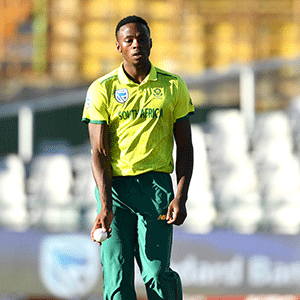[ad_1]

Confident early suggestion for biggest beneficiary of the Proteas’ unusually long period of inactivity when the game finally bursts from the blocks again?
Mine’s Kagiso Rabada.
South Africa’s thoroughbred fast bowler has long been suggested by experts, and not without reason, as one of the most glaring victims of overplay – ahead of the dramatically sports-halting effects of the coronavirus crisis – on the previously merciless global treadmill.
Granted, in the last year or more the Proteas brains trust has more tangibly taken aboard, and perhaps not before time, the need to rotate/rest Rabada at suitable junctures.
But even then, sitting out a Twenty20 mini-series here, a one-day international or two there, doesn’t always do the trick in keeping him both at optimal physical and mental freshness … and he has bowled an awful lot of overs, across the three major formats, since his soon-to-be-spectacular arrival on the highest tier of the game in late 2014.
While his T20 debut for the Proteas against Australia at Adelaide in early November that year was less statistically notable, who could ever forget his ODI equivalent, against Bangladesh at Dhaka in the middle of 2015?
“KG”, then only 20, ripped through the unsuspecting Tigers in their own backyard to claim figures of six for 16 in eight eventful overs: that haul remains the world record for success in maiden appearance in the format, beating off Fidel Edwards’ six for 22 for West Indies against Zimbabwe at Harare in 2003.
He has since established himself, of course, as one of the most lethal pace factors anywhere, a combination of both hostility and cunning, and widely expected to retire – hopefully only many years onward from now – as holder of an array of coveted landmarks.
But the understandable wish to parade Rabada as much as possible as a poster figure in the often challenging landscape that is South African cricket, has seen the sturdily-built, sometimes truculent strike factor just sacrifice a little of his effectiveness in the last two years.
In the period, any regression has hardly been acute, it must be said: he has simply slipped a notch, it can feasibly be submitted, from sublime to very good.
Yet there is some statistical evidence to back up that theory.
In Test matches, for example, Rabada averaged a genuinely stellar 20 with the ball in each of the 2017 and 2018 calendar years, before slipping quite significantly to 27.39 in 2019, while two Tests at home to England in the earliest part of 2020 saw that drop further, for the limited value it has, to 33.42.
When it comes to ODIs, the Johannesburg-born competitor has also retreated from giddier peaks: 2019 was his worst year in average terms (32.12), the first time it has ever drifted out of the 20s on an annual basis.
Nor has most recent T20 activity for the Proteas brought any great personal joy: Rabada was walloped around to a rare extent in the three-match exercise against visitors Australia (2-1 series winners) earlier this year.
He sailed for 45 in only three wicketless overs at his Wanderers home base, then tightened up fairly admirably in earning one for 27 at St George’s Park, before the sluices opened again in the decisive Newlands contest (one for 42).
Rabada’s pace levels have not too noticeably deteriorated in recent months, but he may have succumbed to a more mentally-driven weariness that can be the product of simply too much travel in varying time zones, endless hotel rooms and the constant public relations and fan demands.
He picked up a groin injury in the final T20 contest against the Aussies that would reportedly have meant a four-week gap before he could have joined his Delhi-based franchise in the latest edition of the Indian Premier League had it begun as scheduled.
But even then, just getting over an injury and climbing back into the rigours of high-level cricket at full tilt soon afterwards isn’t a guaranteed recipe for more multi-pronged personal rejuvenation.
Which is why the now very meaningful, rare-as-hen’s-teeth enforced “off-season” – Rabada, remember, hasn’t played any cricket since 26 February – could be just the trick for restoring his loftiest standards, especially if the dormancy stretches for another two months or even more than that.
My fancy is that we’ll see the return of a cricketing Thunderbolt Kid, with apologies to Bill Bryson, when the green light comes once more for the game …
*Follow our chief writer on Twitter: @RobHouwing


















